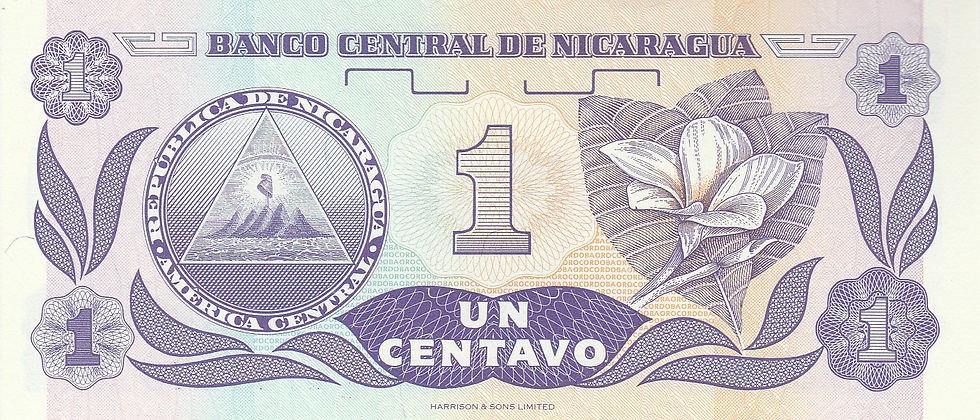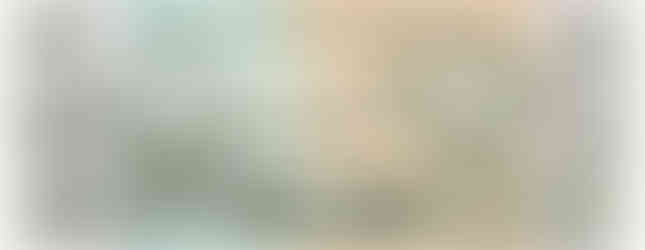This Nicaraguan banknote represents the 1st denomination of the Third Cordoba (1991), printed by Harrison & Sons Limited. Also known as the Cordoba Oro (Gold Cordoba), the Third Cordoba was issued 30 April 1991. After the rapid hyperinflation of the Second Cordoba (1985). The Third Cordoba replaced the Second Cordoba, at an impressive rate of 1 per 5,000,000.
The Third Cordoba was divided into 100 Centavos, unlike the Second Cordoba. Banknotes were issued in 1, 5, 10, 25 Centavo denominations. Which were replaced by chromium-plated steel coins, in the 5, 10, and 25 centavo denomination respectively.
Observe

The observe features a portrait of Francisco Hernández de Córdoba (1475-1526), founder of Nicaragua. The Spanish language header reads “Banco Central de Nicaragua”, or Central Bank of Nicaragua. This text is flanked by Mayan inspired designs, below are a pair of similar patterns. They serve as a positive side of a registration element/light puzzle. A faint floral guilloché pattern can be made out in the background.
The main text is composed of a number “1”, over a large guilloché design. The text reads “UN CENTAVO DE CORDOBA”, or One Cordoba Cent. The note's 1 centavo value is reaffirmed with additional number “1”s on each corner. Each corner features a unique guilloché design, the upper right features a double overlaid guilloché cross.
It interlaces with lower-right guilloché pattern by 9 lines, with a single fold. While the lower left features a single guilloché cross, interlaced with lower-right guilloché pattern by 2 line bundles. The left bundle features 9 lines and right bundle features 10 lines, each with a single fold.
Reverse

The reverse features the Coat of Arms of Nicaragua (left) and a Sacuanjoche. The national flower of Nicaragua, which represents life and fertility in Mayan culture. The header translates to the Central Bank of Nicaragua. Below is a negative for the observe's registration element/light puzzle.
At the center is a number “1”, over a guilloché design. Below is a butterfly-shaped design with the text UN CENTAVO (one cent). The Coat of Arms is ringed by the text Republica De Nicaragua*America Central. Which can be read as the “Central America Republic of Nicaragua”. Or read separately as “Republic of Nicaragua”, ”Central America”.
The note's value is reaffirmed with additional number “1”s on each corner. Each corner features a unique guilloché design, the lower right features an over-lapped double guilloché floral design. There are 3 clusters of 3 wave/flame designs, in-between both the corner guillochés and “butterfly” design.
Founder of Nicaragua

Conquistador Francisco Hernández de Córdoba (1475-1526) is celebrated as the founder of Nicaragua. Córdoba set out of what is now modern Panama, in October 1523. Under the order of colonial administrator Pedrarias Dávila (1440-1531).
The expedition included over 200 men, including a small contingent of cavalry. By 1524, the expedition founded the then colonial towns of León and Granada. There were founded near the indigenous settlements of Jalteba and Imabite, respectably. Little is known of their establishment, due to the letters from Córdoba's correspondence with Dávila have been lost.
The expedition carried parts for a small brigantine (a 2-masted sailing ship), which they built on the shores of Lake Nicaragua. In an attempt to navigate the San Juan river, to the Caribbean Sea. While the river proved to be unnavigable, due to rocky stretches of river and several waterfalls. It was found the river did indeed flow into the Caribbean.
The region was found to be densely forested and heavily populated by indigenous people. Córdoba sent a party to search inland. They covered 80 leagues (335 km/208 mi) before returning back. After finding no navigable waterways.
Security Measures

The note's surface is covered in a series of micro-print, composed small irregular blocks containing opposing lines. There are additional patterns utilized, including an additional under-print pattern. If one closely examines the reverse, they will another unique pattern. Inside of each of the reverse's “flame” designs is an over-lapping circle micro-print pattern.
These relatively elaborate security measure are further reinforced by additional methods. In the reverse's background is micro-text, that repeats the name “CORDOBA”. The text printed interconnected, with no spacing in-between. The text's color changes with the note's under-print, making it more difficult to notice when unaided.
As a final measure the note's surface utilizes ultraviolet-sensitive ink and embedded fibers (SEE: Ultraviolet Gallery). These relatively easy to spot fibers, appear as red, blue, and black under visible light. Turning a bright white once exposed to ultraviolet light. Doing so will also reveal the note's value, on the observe's left.
Size Comparison

Ultraviolet Gallery
Third Cordoba-Centavo Gallery
(Gallery contains all Centavo denominated banknotes of the 1991 Third Cordoba)
Additional Notes
The note's dimensions are 120 mm x 45 mm or 4.72 in x 2.09 in, smaller than a US Dollar.
The preferred method to preserve this note, is a side opening protective sleeve cut to size.
The Third Cordoba ISO 4217 code is NIO, it uses C$ as its official symbol.






















Comments